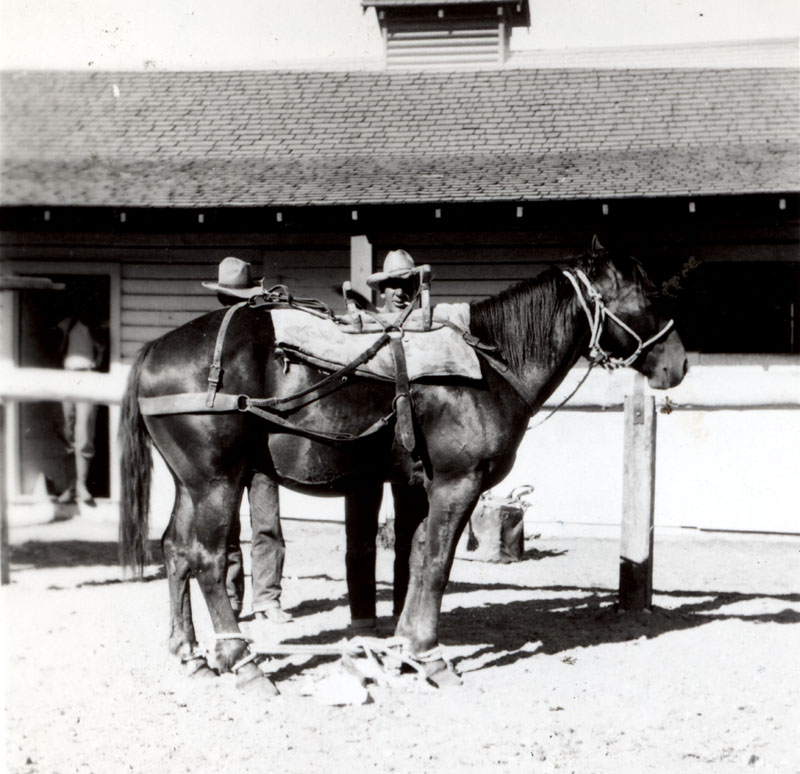Decades before GPS units, cell phones and SUVs with 4-wheel drive, collectors valiantly journeyed into difficult terrain and remote, never-before-collected locations to bring valuable specimens back to the MVZ. With roads and settlements in these localities not yet constructed, such expeditions were lucky if they found a trail to follow. Combined with a lack of easy communication methods, such treacherous traveling conditions had the potential to create unforeseen complications for the collectors.
The story described in “Horse Down”, presented as a display at Cal Day on April 21, 2012, is just one example of the challenges that collectors willingly faced and boldly overcame for the sake of the MVZ’s research and collections.
……………………………………………………………………………………………………………………………….
Horse Down: The “Thrills and Spills” of a Pack Train’s Journey through Sweetwater Canyon
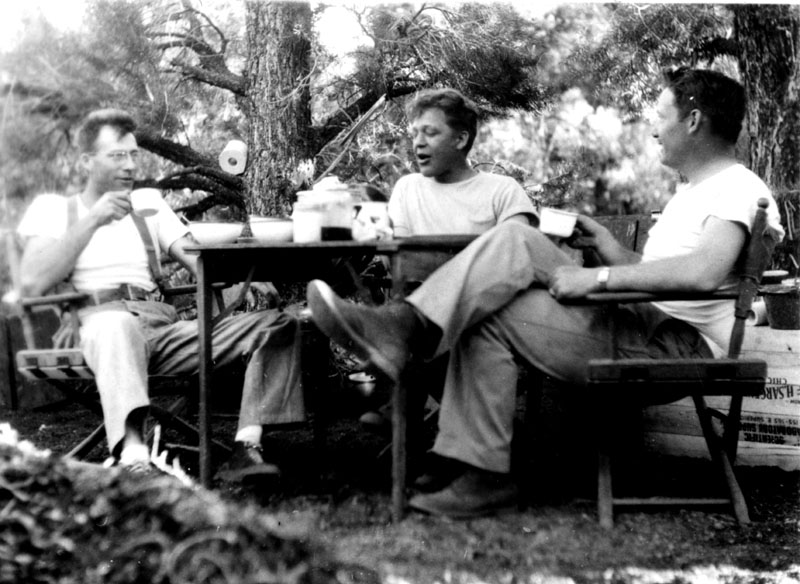
The three collectors in camp at dinner: Ward C. Russell, Dr. Seth Benson, and Joye H. Severaid, 6:30 pm. July 10, 1946.
In July of 1946, guided by two men named Francis Brown and Jack Kelly, MVZ collectors Seth B. Benson, Ward C. Russell, and Joye H. Severaid ventured on horseback into Sweetwater Canyon in Mono County, California. Unfortunately, the journey became increasingly difficult as two of their pack horses, Chappo and Brownie, refused to behave. The horses bucked and reared, flinging the scientist’s equipment, camping supplies, and food all over the trail. The collectors tried to regain the upper hand, roping the packs down on the horses and even tying Chappo’s feet together. Unfortunately, despite the many attempts by the “forlorn collectors” to control these very “wild horses,” the expedition turned deadly for one of the animals.
The following excerpts from Severaid’s July 15, 1946 field notes describe this arduous journey.
Joye H. Severaid’s Field Notes
Sweetwater Canyon
Monday, July 15, 1946
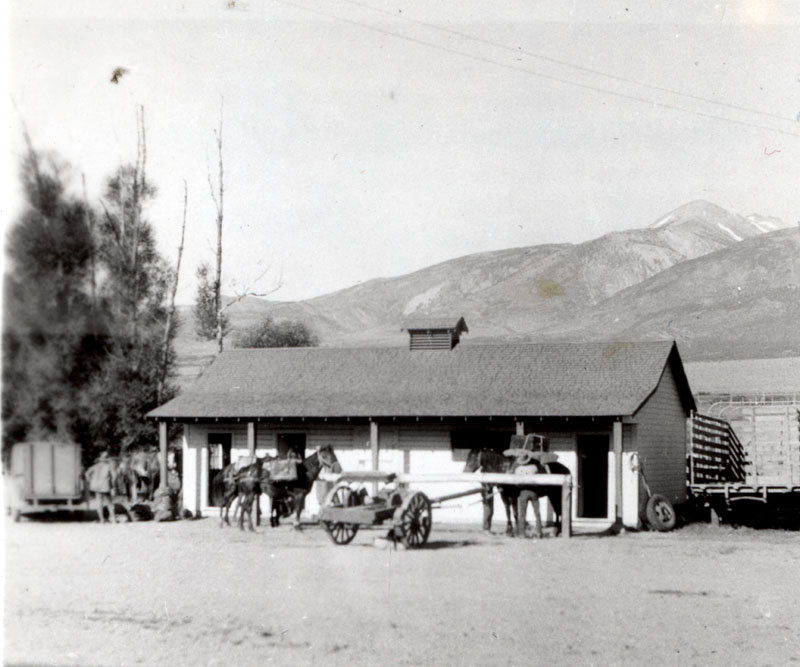
The stables at the Sweetwater Ranch, showing the 3 pack horses loaded and ready for the pack trip. July 15, 1946.
Up at 5:30. By 6:30 we began hauling our equipment down to the barns where the horses were to be loaded.
Then the fireworks began. No Rodeo could have provided more “thrills and spills” than this, our first pack trip. It seems that 2 of the 3 pack horses had not been worked for quite some time, had been born ornery and gotten worse since, and were at least partially loco in the head. All the most valuable equipment was placed on an old black draft horse, but the food, traps, cooking utensils and sleeping bags were placed on Chappo and Brownie, whose dispositions were known to be anything but commendable. As we were putting the tent poles on Brownie, he reared up. This set Chappo off, who bucked until he had half freed himself of his entire pack, the latter being strewn all over the ground. We stood with mouth open, as it were, as we saw our cooking utensils strewn about and trampled in the dust.
The session over, we picked up our scattered gear and repacked same. In the meantime, Mr. Brown and Jack Kelly tied all four of Chappo’s feet together so if he bucked again he’d wish he hadn’t.
Then they finished loading Brownie’s pack and tied him off at a distance. Then back to Chappo. Yes, he bucked again, this time flinging himself to the ground. At this point he was flogged, doused with water and otherwise tampered with until he was used to the idea of movement about him. When at last he got to his feet again he looked mean but appeared meek when everything in the book was waved around his head and body. So his pack was loaded again and tied on very well. We thought everything would be okay now but at this point Chappo bucked again, threw himself to the ground and tried to roll his pack off, without success. They got him to his feet again, checked his pack, and we were ready to take off. The saddle horses were brought up. They too were flighty by this time as they had “seen all”. We mounted our horses at 8:30. Within 10 minutes we were off to the mountains, Jack Kelly leading Chappo, Mr. Brown leading Brownie, Russell leading the old black horse, Dr. Benson on Lonesome at the head, and myself on Red bringing up the rear to pick up anything that might fall off the packs. Everything seemed to be going well.
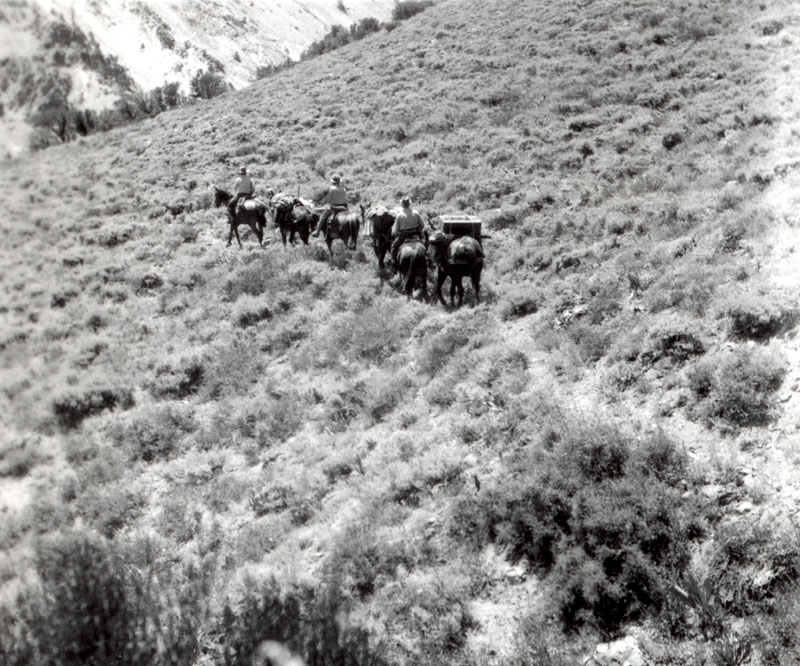
The pack train about half way up Sweetwater Canyon. Back to front: Severaid on “Red” leading “Blackie”, Dr. Benson on “Lonesome” leading “Brownie”, and Jack Kelly on “Traveller” leading “Chappo”. Photo taken by Russell, July 15, 1946.
We went up Sweetwater Canyon to a point just below the cabin where we had our first camp. There Mr. Brown left us, taking two of the saddle horses with him.
At about 10:30 we started out again following the trail. There was no longer a road, it having ended at the cabin. The two “wild horses” still acted up and tried to roll every time we stopped, so we couldn’t rest them as we’d have liked. We made the head of the canyon around 11:30 with little incidence, but then the trouble began. The rock slides are very steep at this point in the canyon. The trails are narrow but sufficiently crisscrossing to make the ascent possible.
About 1/3 of the way up Chappo began bucking, got off the trail and sunk up to his knees in the loose gravel. Chappo kept bucking until he fell down and there he lay. Meanwhile Brownie had started to buck and got off the trail too. He started down hill, fell, and rolled over three complete times, stopping then in a heap, Russell still hanging on to its lead rope. Brownie’s pack was still intact but badly crushed and our groceries fell out as he rolled. Oranges, potatoes, walnuts, bread, glass jars and canned goods went rolling down the hill.
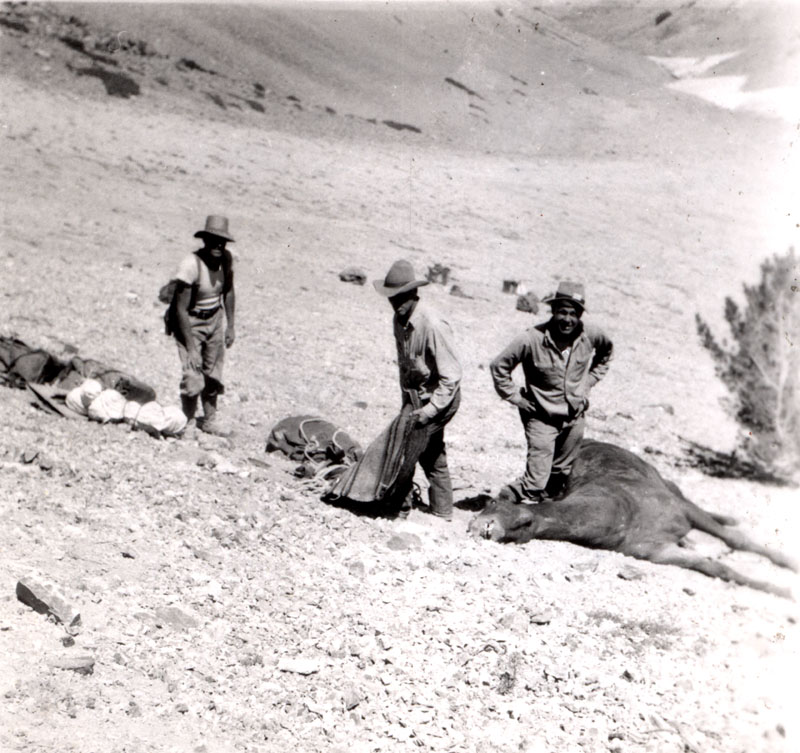
Chappo died from his injuries. He is shown here after the collectors took his pack off. Brownie’s pack is seen in the background, down grade. Left to right: Russell, Kelly the guide, Dr. Benson and Chappo. July 15, 1946.
Meanwhile Chappo tried to get up again but couldn’t make it. He lay back down breathing heavily. We took the pack off Brownie and got him back on his feet, then gathered up our scattered groceries. When we went up to take the pack off Chappo, the poor loco bronco was dead. We removed his pack, harness and halter. The saddle horses and Blackie had been tied to some small trees growing on the slope. Thus too did we tie Brownie. Then we spent most of an hour resting from our ordeal and collected our thoughts.
After some time of more difficult terrain and supplies flung across the trail, the shaken-up men and the remaining horses in the pack train eventually made it to their camp site at the head of Desert Creek Canyon around 4:45pm.
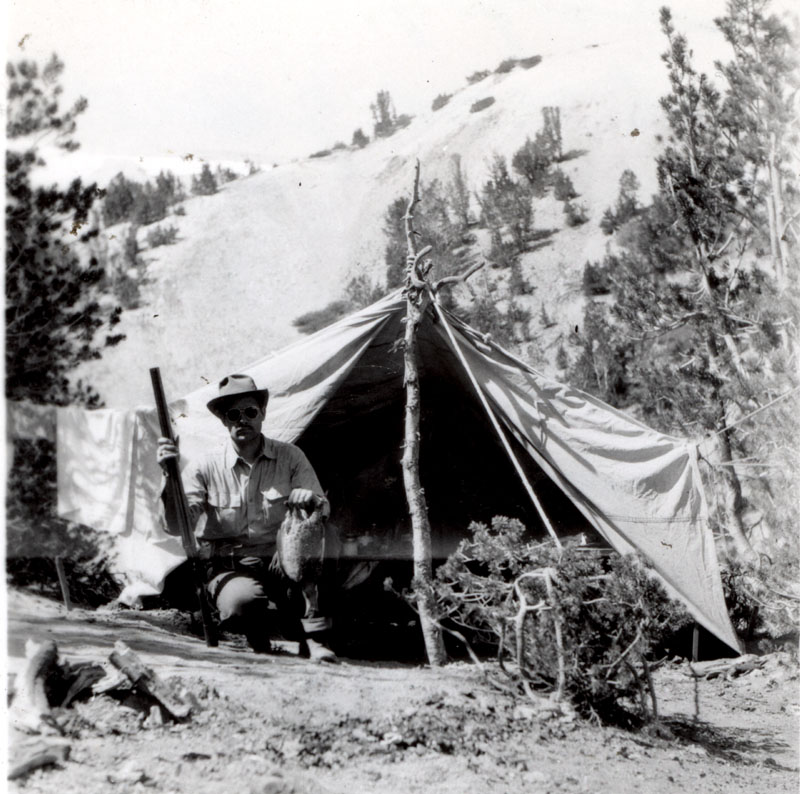
The next day! Camp at the summit of Desert Creek Canyon. Joye H. Severaid and 2 grouse. July 16, 1946.
Kelly started back with the 5 horses. We now had time to survey the damage to our equipment. Three loaves of bread were missing, most of four dozen eggs were broken, 2 of our Calco boxes were all smashed to kindling and our pots and pans were pretty well dented. Strangely enough none of the glass jars had broken. We set up our tent as quickly as possible, Benson made supper and we laid out our sleeping bags. At 8:45 we went to bed, three tired and forlorn collectors.

